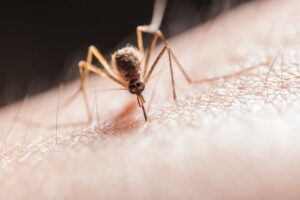Physical Address
23,24,25 & 26, 2nd Floor, Software Technology Park India, Opp: Garware Stadium,MIDC, Chikalthana, Aurangabad, Maharashtra – 431001 India
Physical Address
23,24,25 & 26, 2nd Floor, Software Technology Park India, Opp: Garware Stadium,MIDC, Chikalthana, Aurangabad, Maharashtra – 431001 India

By Aayushi Sharma
Climate change, characterized by rising global temperatures, altered precipitation patterns, and increased frequency of extreme weather events, is not only a significant environmental concern but also a major public health threat. One of the less obvious but increasingly alarming consequences of climate change is its impact on vector-borne diseases, particularly dengue fever. Dengue, a mosquito-borne viral infection, has seen a dramatic rise in incidence in recent decades.
Understanding Dengue Fever
Dengue fever is caused by the dengue virus (DENV), which has four distinct serotypes. It is transmitted primarily by the Aedes aegypti mosquito, and to a lesser extent, the Aedes albopictus mosquito. Symptoms of dengue include high fever, severe headache, pain behind the eyes, joint and muscle pain, rash, and mild bleeding. Severe dengue, also known as dengue hemorrhagic fever, can cause significant bleeding, sudden drops in blood pressure, and death. There is no specific treatment for dengue, and prevention relies heavily on controlling mosquito populations and preventing mosquito bites.
The Link Between Climate Change and Dengue
Temperature Increase and Mosquito Habitats
Mosquitoes are ectothermic organisms, meaning their body temperature and biological processes are influenced by the ambient temperature. Higher temperatures accelerate the life cycle of mosquitoes, reducing the time required for the development of larvae into adult mosquitoes. Additionally, higher temperatures shorten the incubation period of the dengue virus within the mosquito, increasing the likelihood of transmission to humans. As global temperatures rise, regions that were previously too cold for Aedes mosquitoes are becoming suitable habitats, expanding the geographic range of dengue.
Changes in Rainfall Patterns
Ambient temperature and rainfall are two critical factors that regulate the environmental suitability for the transmission of most mosquito-borne infectious diseases, such as Zika and dengue fever. (Yang et. al 2009). Climate change is also altering precipitation patterns, with some regions experiencing increased rainfall while others face prolonged droughts. Heavy rainfall can create numerous breeding sites for mosquitoes by increasing the number of stagnant water bodies. Conversely, droughts often lead to water storage in containers, which also serve as breeding sites for Aedes mosquitoes. Both scenarios contribute to the proliferation of mosquito populations, enhancing the risk of dengue transmission.
Extreme Weather Events
Extreme weather events, such as hurricanes, floods, and cyclones, are becoming more frequent and intense due to climate change. These events can disrupt infrastructure, leading to water accumulation and increased mosquito breeding sites. Additionally, the displacement of populations and the breakdown of public health systems during such events can hinder vector control efforts and exacerbate the spread of dengue.
The Expanding Threat of Dengue
Historically, dengue was confined to tropical and subtropical regions. However, with climate change, dengue has been expanded into temperate regions. Countries that were previously dengue-free, including parts of Europe and North America, are now reporting cases of local transmission. For instance, autochthonous cases of dengue have been documented in France and Croatia, indicating the presence of competent mosquito vectors in these regions.
The global incidence of dengue has increased significantly over the past few decades. The World Health Organization (WHO) estimates that there are 390 million dengue infections annually, with about 96 million manifesting clinically. The rapid urbanization and population growth in many tropical and subtropical regions have contributed to this surge, but climate change remains a critical underlying factor driving this trend.
The combination of expanding mosquito habitats, increased mosquito populations, and more frequent human-mosquito interactions creates a fertile ground for dengue epidemics. The cyclical nature of dengue outbreaks, driven by the interplay of different dengue serotypes and the build-up of susceptible populations, means that large-scale outbreaks can occur with little warning. The potential for severe outbreaks is particularly high in areas with inadequate vector control and healthcare infrastructure.
Dr. A. B. Mathur, General Physician told CFC India in this regard, “Strengthening public health infrastructure is crucial for effective dengue surveillance, diagnosis, and treatment. This includes training healthcare workers, improving diagnostic facilities, and ensuring the availability of medical supplies. Also, public awareness campaigns can educate communities about the importance of eliminating mosquito breeding sites and protecting themselves from mosquito bites. Community engagement also fosters a sense of ownership and responsibility in combating dengue.”
References:
https://www.sciencedirect.com/science/article/pii/S2468042723000428
https://www.who.int/news-room/fact-sheets/detail/dengue-and-severe-dengue
https://www.thelancet.com/journals/lancet/article/PIIS0140-6736(23)00226-X/fulltext
Banner Image: Photo by Jimmy Chan https://www.pexels.com/photo/mosquito-biting-on-skin-2382223/
Photo by Anuj https://www.pexels.com/photo/mosquito-sucking-blood-on-skin-of-unrecognizable-person-4189472/